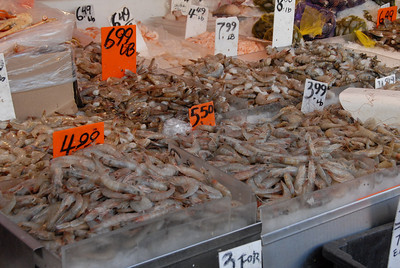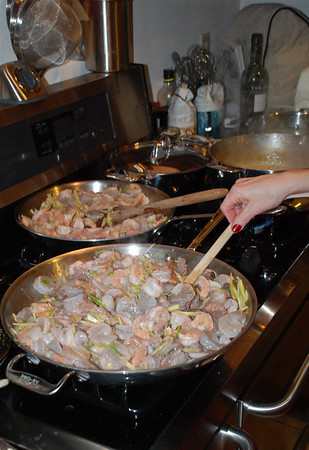They’re Americans’ favorite shellfish and, after canned tuna, their preferred seafood. Yet, until the 20th century, shrimp were not readily available to diners. Unless you lived in the South, where shrimp were sold live, you missed out on these flavorful, little crustaceans. By the early 1900’s, though, advances in fishing trawler refrigeration allowed the mass marketing of and subsequent nationwide craze for shrimp.

Over 300 species exist worldwide but I tend to find six or seven in our markets. Gulf White, Pink and Brown, Ecuadoran or Mexican White, Chinese White, Black Tiger and Rock are the types that I see. As the names suggest, Gulf shrimp hail from the Gulf Coast, Chinese and Black Tiger come from Asia, etc. Of these Black Tiger is the largest, growing up to one-foot in length. It’s also one of the more expensive. As a general rule, the larger the shrimp, the higher the cost.
Buy shrimp and you buy according to number per pound or count. The smaller the number in the count, the larger the shrimp will be. You’ll need only 10 or less colossal shrimp to make a pound. With jumbo shrimp it’s 11 to 15 per pound. Extra-large is 16 to 20. Large needs 21 to 30. Medium requires 31 to 35 while small has a count of 26 to 45.
When purchasing shrimp, you’ll end up buying frozen or frozen that has been defrosted and displayed in your fishmonger’s case. As there’s no benefit to defrosted shrimp, go with frozen. That way you don’t have to use it right away. Nor do you need to fret over how long it’s been hanging around in the case. If you do opt for defrosted, smell the shrimp before buying it. If you get a whiff of ammonia or other off odors, skip it. Likewise, stay away from shrimp with pitted, yellow or spotted shells and those that feel mushy.
Why do Americans love shrimp? I can think of a slew of reasons, including simplicity, versatility, ease of preparation and flavor. I can bake, boil, broil, deep-fry, grill, poach, roast, saute, steam or stir-fry these guys. I can serve them with a splash of lemon juice or cocktail sauce, lay them over a bed of lettuce or pasta, layer them in a sandwich or feature them in a stir fry. They require only a minimal amount of cooking — just until they turn pink — and have a wonderfully nutty taste.

One of my favorite ways to prepare shrimp is to saute them with a bit of ginger, garlic, spring onion, olive oil and sherry. The end result is Ginger-Scallion Shrimp, a quick, easy and delicious dish.
SAUTEED GINGER-SCALLION SHRIMP
Serves 4
1 pound frozen jumbo or extra large shrimp
3 scallions, washed
1 medium-sized fresh ginger root, peeled
2 cloves garlic, peeled
2 tablespoons olive oil
generous splash of Tio Pepe sherry
Defrost the shrimp in the refrigerator or in a bowl of cold water. Peel them and set aside.
Slice the scallions, ginger and garlic into spiky matchsticks. Place them in a large saute or frying pan, add the oil and heat on medium, stirring occasionally. Once the vegetables have started simmering, add the peeled shrimp and toss to combine. Cook for 3 to 5 minutes, tossing periodically. When finished, the shrimp will have turned coral pink in color. Add the sherry, toss to combine again and serve immediately with slices of Italian or French bread.